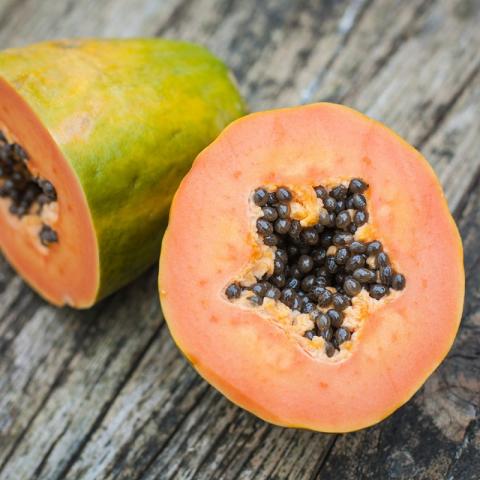Product image
Image

Texte du corps du produit
The papaya tree, cultivated by the Amerindians since very ancient times, would have originated in the south of Mexico. It was introduced to the West Indies during colonization. The Spanish imported it to the Philippines in 1555. It is now found in all tropical areas of the globe.
This giant semi-woody grass can reach 7 meters high. Its straight trunk ends in a large crown of leaves under which are born fragrant flowers of white-cream or yellow color. The papaya tree is either male or female but the varieties selected are hermaphrodites. The fruit has the distinction of growing directly on the trunk. It is a green berry which becomes yellow-orange or even red when ripe. Its shape, oval-elongated to globose, and its size vary according to the varieties. The center of the fruit usually contains many small black seeds with a pungent taste and deworming properties. Cut in half, the ripe papaya with orange flesh reveals a variable flavor depending on the variety: bland or on the contrary very fragrant and sweet.
It is then eaten with a drizzle of lemon. Papaya is also appreciated green. Raw, it will be prepared in a vinaigrette after having grated it. Cooked, it will be used as a vegetable. Ripe or green papaya jams will delight the family. A low-calorie, well-digested fruit, papaya is full of vitamin C (400 mg per 100 g of pulp) and provitamin A (1000 IU per 100 g of pulp). Each part of the plant contains a white latex rich in papain capable of digesting proteins. It is used to tenderize meats or Queen Conch.
This giant semi-woody grass can reach 7 meters high. Its straight trunk ends in a large crown of leaves under which are born fragrant flowers of white-cream or yellow color. The papaya tree is either male or female but the varieties selected are hermaphrodites. The fruit has the distinction of growing directly on the trunk. It is a green berry which becomes yellow-orange or even red when ripe. Its shape, oval-elongated to globose, and its size vary according to the varieties. The center of the fruit usually contains many small black seeds with a pungent taste and deworming properties. Cut in half, the ripe papaya with orange flesh reveals a variable flavor depending on the variety: bland or on the contrary very fragrant and sweet.
It is then eaten with a drizzle of lemon. Papaya is also appreciated green. Raw, it will be prepared in a vinaigrette after having grated it. Cooked, it will be used as a vegetable. Ripe or green papaya jams will delight the family. A low-calorie, well-digested fruit, papaya is full of vitamin C (400 mg per 100 g of pulp) and provitamin A (1000 IU per 100 g of pulp). Each part of the plant contains a white latex rich in papain capable of digesting proteins. It is used to tenderize meats or Queen Conch.
Association des Agriculteurs du CONGO
- http://www.commerce.gouv.cg/aac
- aac@commerce.gouv.cg
- Brazzaville, République Congo
- 066666666